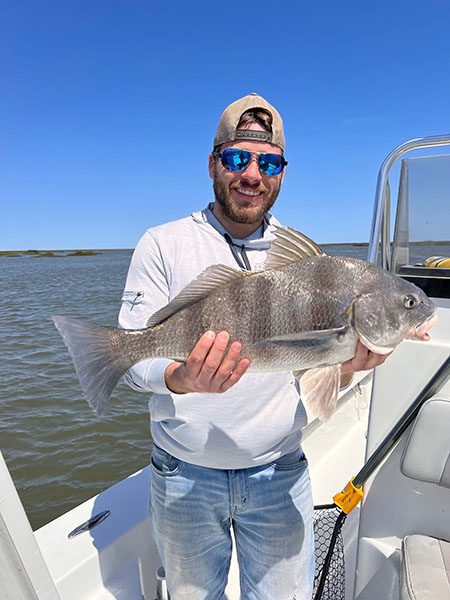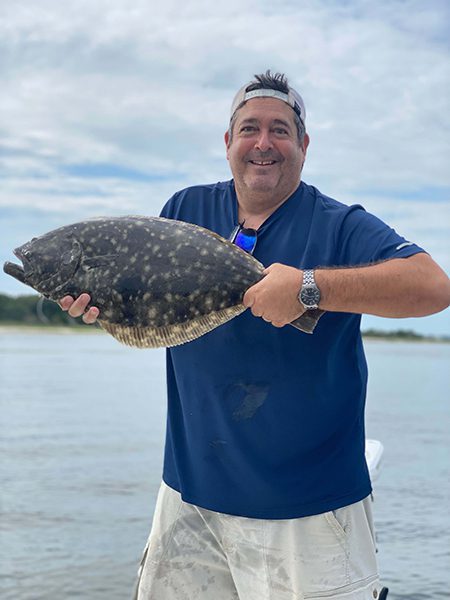Carolina Beach – August 2022
Andrew, of Island Tackle and Hardware, reports that anglers have been catching some good-sized sheepshead. Live fiddler crabs fished around dock pilings and hard structures from the ICW back into the Cape Fear River have been enticing strikes from these tasty fish.
Anglers fishing structured areas with Carolina-rigged live baits or soft plastics on heavier jig heads have been hooking plenty of catch-and-release flounder.
Anglers from the surf have mostly had success with a variety of bottom fish species, including croakers and pinfish.
On days you can get off the beach, bottom fishing is the top target for many anglers. Running to structure in the 15-30 mile range is producing good numbers of grouper and vermilion snapper.

Forrest Malpass hooked this 23″ black drum on dead shrimp in the Lower Cape Fear River. He was fishing with Capt. Christian Wolfe of Seahawk Inshore Fishing Charters.
Christian, of Seahawk Inshore Fishing Charters, reports that summertime anglers have been catching red drum, with a mixed bag of both under-, lower-, and mid-slot fish. The schools of finger mullet are now big enough to cast net, so most anglers have been having success fishing them on Carolina rigs or jig heads. The slack tides have seemed to produce the best action.
Anglers are catching some decent flounder with the same bottom-rigged live baits. Flatfish in the 16-20” range seem to be feeding best on the higher end of tide cycles.
Black drum are scattered throughout deep holes with nearby structure or in some of the same areas that are holding reds. Dead shrimp fished on the bottom works best for this bite.
Luke, of Spot On Charters, reports that there continues to be a solid bite on red drum throughout the Cape Fear River. Even with recent rains, there is great salinity and good water well upriver, allowing anglers to target spots they usually wouldn’t. Carolina-rigged live baits are providing plenty of action.
Flounder catch-and-release fishing is super strong throughout the region. Anglers are having plenty of success targeting the deeper pockets and ledges with 2-3’ drop-offs with the same Carolina-rigged baits.
Tommy, of Mungo Fishing Charters, reports that with recent strong wind patterns, red drum fishing has mostly been a game of “bait and wait” using live pogies. The schools of finger mullet moving around are now large enough to be netted, and anglers will also have success Carolina rigging them and fishing oyster lines closer to deep water. A favorite tactic for the reds is to target flats and shallow water creeks on the nice calm days with topwater baits such as Rapala Skitter Walks. Gulp shrimp can also be very effective in these areas.
Speckled trout fishing has been good for anglers using a variety of techniques from live bait to soft plastics and topwater plugs. Fishing higher tide cycles over the top of oyster beds and marsh edges is a great tactic for this time of year.
Anglers with patience will have success catching some black drum with fresh dead shrimp. Targeting deep structures and oyster bars is where this action will be found, but there are also plenty of small fish around to steal bait.
Good numbers of flounder are still being caught, and both live baits and soft plastics fished on the bottom are enticing strikes.
Mason, of Grand Slam Fishing Charters, reports that redfish action has been steady through these hot summer days. Anglers are having success targeting the reds with Carolina-rigged baits fished on deeper banks with nearby structure. The redfish seem to be pretty aggressive right now, so using larger finger mullet is likely to produce more strikes. Anglers are also having success targeting the redfish using topwater plugs, Gulp soft plastics, and gold spoons. The key has been to target areas with current flow and bait staged up.
Speckled trout action has been good on the right mornings. Overcast weather paired with light winds have been the best conditions, and topwater plugs and soft plastic jerk shads are both successful in getting strikes.
Flounder are being caught throughout the river by anglers fishing Carolina-rigged mullet. Targeting creek mouths and points on the falling tide cycles have been producing the most action.

Jeff Aricola, of Wilmington, caught (and released) this 26″ flounder on a live finger mullet in the Carolina Beach area. He was fishing with Ryan Murray.
Rod, of OnMyWay Fishing Charters, reports that spanish mackerel have thinned out along the beach. The key to finding action has been to run around until finding pogie schools. Some of these bait pods have been staged outside Carolina Beach Inlet on the falling tide cycles. Anglers running north (to up around Figure 8) have been finding some of the larger spanish. Clarkspoon setups are successful in producing both the big and small fish.
King mackerel have been scattered from anywhere in the 5-25 mile range. There isn’t a big concentration of them anywhere, but targeting the good blue/green “king” water from 14 miles on out with live bait has been the best bet to get a strike.
Bottom fishing is always a great summertime staple for the region. The 15-25 mile range is producing smaller grouper and plenty of black sea bass. Out deeper in the 24+ mile range, anglers will find more of the larger bottom fish species.
Heading out to the break, some good-sized wahoo are being caught in the 140-180’ range. A few blackfin tuna are mixed in.
Mahi are scattered just about everywhere in both the good blue water and some of the blue/green water. This time of year there are no hard temperature breaks to target, so anglers should pay more attention to chlorophyll breaks offshore.
Some sailfish are also showing up and will be mixed in the counts when finding pockets of good blue water.
Anthony, of Kure Beach Pier, reports that bottom rigs tipped with fresh shrimp or artificial bait strips have been catching plenty of croakers.
There are schools of spanish mackerel still working by the pier for those casting Gotcha plugs at the surface-feeding schools.
A few kings (to 32 lbs.) are being caught from anglers fishing live baits off the end, and some sheepshead (to 7.1 lbs.) are feeding on baits up against the pilings.





